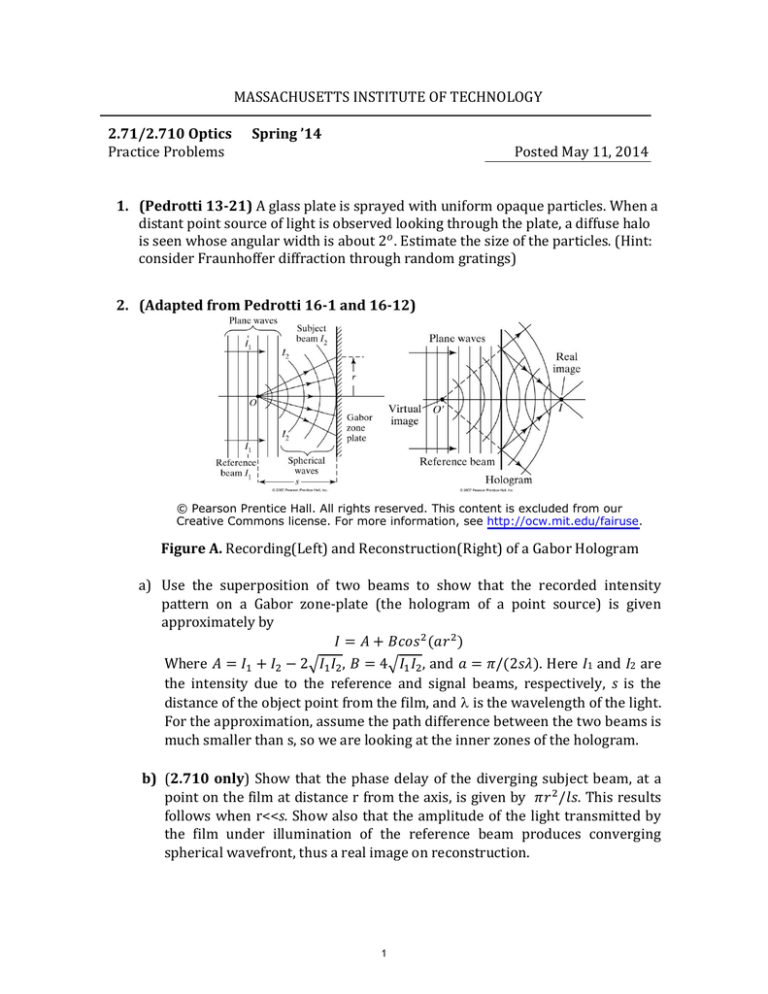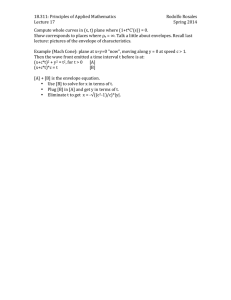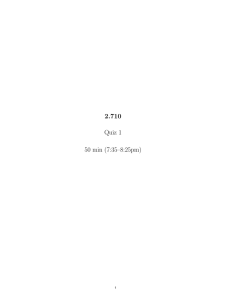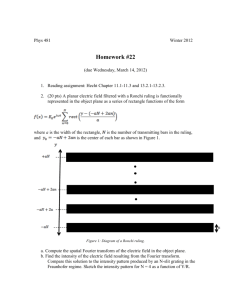
MASSACHUSETTS INSTITUTE OF TECHNOLOGY
2.71/2.710 Optics
Practice Problems
Spring ’14
Posted May 11, 2014
1. (Pedrotti 13-21) A glass plate is sprayed with uniform opaque particles. When a
distant point source of light is observed looking through the plate, a diffuse halo
is seen whose angular width is about 2𝑜 . Estimate the size of the particles. (Hint:
consider Fraunhoffer diffraction through random gratings)
2. (Adapted from Pedrotti 16-1 and 16-12)
© Pearson Prentice Hall. All rights reserved. This content is excluded from our
Creative Commons license. For more information, see http://ocw.mit.edu/fairuse.
Figure A. Recording(Left) and Reconstruction(Right) of a Gabor Hologram
a) Use the superposition of two beams to show that the recorded intensity
pattern on a Gabor zone-plate (the hologram of a point source) is given
approximately by
𝐼 = 𝐴 + 𝐵𝑐𝑜𝑠 2 (𝑎𝑟 2 )
Where 𝐴 = 𝐼1 + 𝐼2 − 2√𝐼1 𝐼2 , 𝐵 = 4√𝐼1 𝐼2, and 𝑎 = 𝜋/(2𝑠𝜆). Here I1 and I2 are
the intensity due to the reference and signal beams, respectively, s is the
distance of the object point from the film, and is the wavelength of the light.
For the approximation, assume the path difference between the two beams is
much smaller than s, so we are looking at the inner zones of the hologram.
b) (2.710 only) Show that the phase delay of the diverging subject beam, at a
point on the film at distance r from the axis, is given by 𝜋𝑟 2 /𝑙𝑠. This results
follows when r<<s. Show also that the amplitude of the light transmitted by
the film under illumination of the reference beam produces converging
spherical wavefront, thus a real image on reconstruction.
1
3. Modulation Transfer Function:
The measured modulation transfer function (MTF) of an optical lithography
system is given in the figure below. The system is illuminated with spatially
incoherent light at 400nm wavelength. The intensity pattern at the input plane of
the system is given by
2𝜋𝑥
2𝜋𝑥
1
) + 𝑐𝑜𝑠 (
)]
𝐼(𝑥) = [1 + 𝑐𝑜𝑠 (
50𝜇𝑚
10𝜇𝑚
2
1.0
MTF
0.8
0.6
0.4
0.2
100
1000
Spatial Frequency (line pair/mm)
a) What is the contrast of the intensity pattern at the input plane?
b) Plot the intensity pattern formed at the output plane, and calculate the
image contrast.
c) Can you guess the coherent transfer function and cut-off spatial frequency
for this imaging system?
2
4. Consider the optical system shown the following schematic, where lenses L1, L2
are identical with focal length f and diameter 2a. A thin-transparency object T1 is
placed at distance 2f to the left of L1.
Object
T1
L2
L1
2f
3f
a) Where is the image formed? Use geometrical optics, ignoring the lens apertures
for the moment.
b) If the object T1 is an on-axis point source, describe the Fraunhofer diffraction
pattern of the field to the right of L2.
c) How are your two previous answers consistent within the approximations of
paraxial geometrical and wave optics?
d) The point source object T1 is replaced by a clear aperture of full width w and a
second thin transparency T2 is placed between the two lenses, at distance f to the
left of L2. The system is illuminated coherently with a monochromatic on-axis
plane wave at wavelength λ. Write an expression for the field at distance 2f to
the right of L2 and interpret the expression that you found.
e) Derive and sketch approximately, with as much quantitative detail as you can,
the intensity observed at distance 2f to the right of L2 when T2 is an infinite
sinusoidal amplitude grating of period Λ, such that Λ « a.
f) (2.710 only) Now we want to place a picture of zebra as T1, and make a copy of
the zebra image that removes the black and white stripes. A careful examination
of the picture T1 shows the stripe patterns are approximately periodical with
center to center spacing of 0.5mm and black stripe width of 0.1mm. The picture
T1 is 20mm wide and 10 mm tall. The lens L2 is moved to a distance of 3.5f to the
right of L1. The focal length f =250mm for both lenses L1 and L2. Can you design a
transparency mask T2 for this filtering application for coherent and incoherent
illumination? T2 is placed at distance f to the left of L2.
3
5. (2.710 only) Zernicke phase mask. You are given an imaging system which
consists of two thin transparencies T1, T2 and two thin lenses L1, L2 arranged as
shown in Figure A. The shapes and dimensions of T1, T2 are shown immediately
below in Figure B.
x
x’
f1
f1
x”
f2
f2
z
T1
L1
T2
L2
Figure A (not to scale)
T1
air
z
1µm
10µm
glass,
n =1.5
x
z
a=3cm
0.5µm
air
T2
glass,
n =1.5
opaque
b=7cm
opaque
x’
Figure B (not to scale)
Transparency T1 is infinitely large in the x dimension. Lenses L1, L2 are identical,
with infinitely large apertures and focal lengths f1 = f2 = 10cm. Numerical values
for the symbols a, b denoting lateral feature sizes of T2 are defined in Figure B.
4
The illumination is an on–axis plane wave at wavelength λ = 1µm. The observation
plane is located one focal distance behind L2.
a) What is the intensity immediately after T1?
b) What is the optical field immediately before T2?
c) What is the intensity measured at the observation plane?
d) Comparing your answers (a) and (c), how is T2 helpful in imaging the phase
object T1?
e) Consider the limit b → ∞. How does then answer (c) change? Is the larger
aperture helpful in this case?
f) If a = 0.5cm and b → ∞, is your answer (d) still valid? If yes, why? If not, what
has gone wrong?
5
MIT OpenCourseWare
http://ocw.mit.edu
2.71 / 2.710 Optics
Spring 2014
For information about citing these materials or our Terms of Use, visit: http://ocw.mit.edu/terms.





